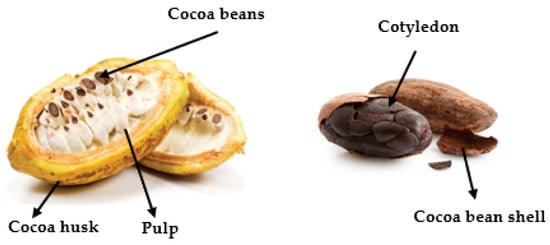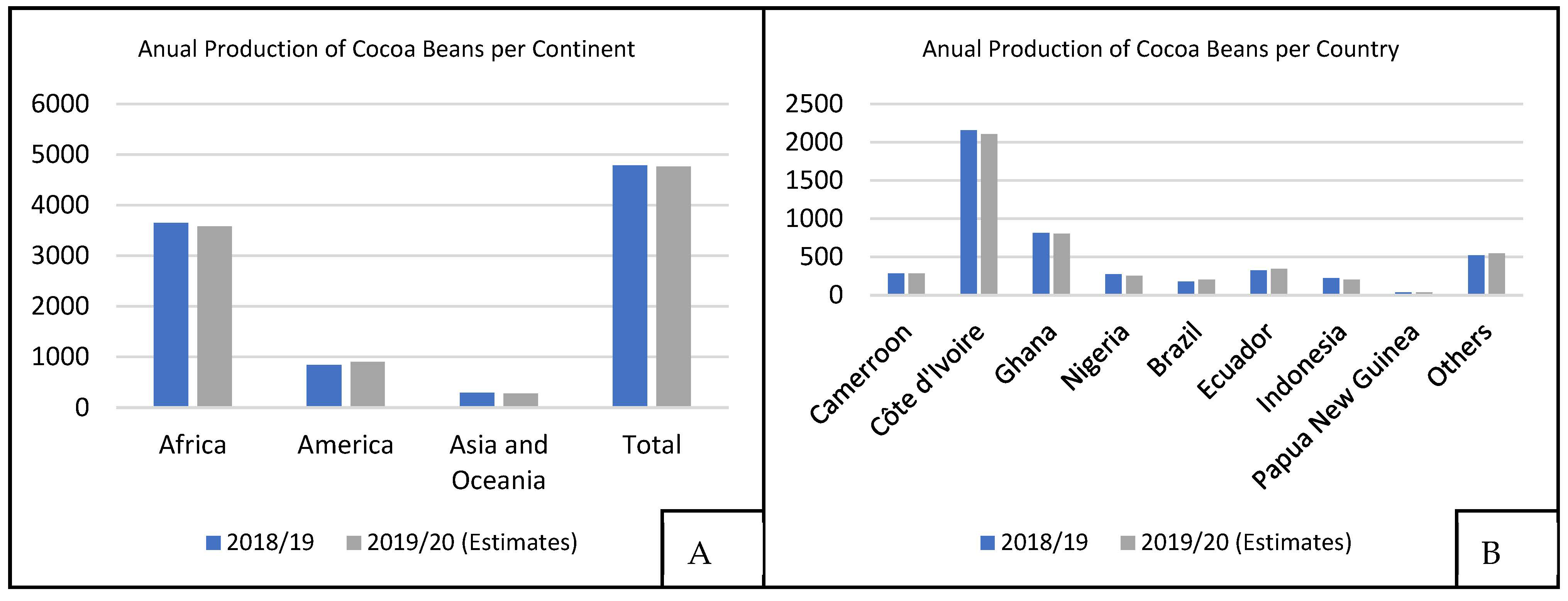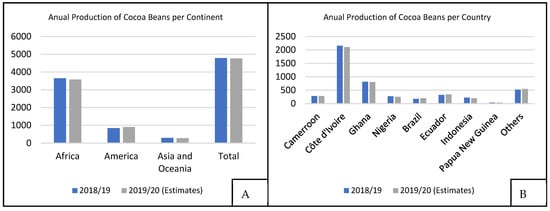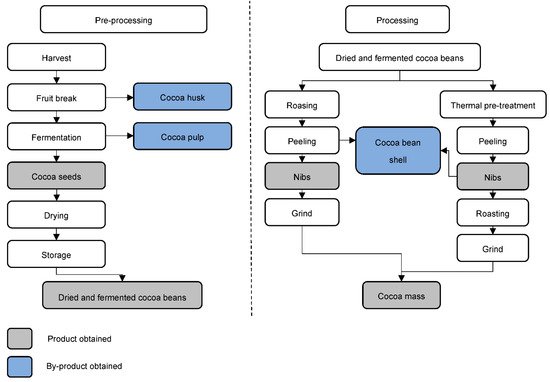You're using an outdated browser. Please upgrade to a modern browser for the best experience.
Please note this is a comparison between Version 1 by Thiago Soares and Version 3 by Camila Xu.
Theobroma cacao L., the cocoa-producing tree, belongs to the order of Malvales, family Malvaceae and genus Theobroma. Its name has Greek origins, Theos and Bromos, meaning “food of the gods”.
- cocoa beans
- cocoa by-products
- circular economy
1. Introduction
Theobroma cacao L., the cocoa-producing tree, belongs to the order of Malvales, family Malvaceae and genus Theobroma. Its name has Greek origins, Theos and Bromos, meaning “food of the gods” [1]. It is the only plant with commercial use in the production of chocolate. Despite having a pulp with a pleasant flavour, cocoa seed is the part of cocoa mostly used in the food industry, generating several products (
1. Introduction
Theobroma cacao L., the cocoa-producing tree, belongs to the order of Malvales, family Malvaceae and genus Theobroma. Its name has Greek origins, Theos and Bromos, meaning “food of the gods” [1]. It is the only plant with commercial use in the production of chocolate. Despite having a pulp with a pleasant flavour, cocoa seed is the part of cocoa mostly used in the food industry, generating several products (


There are some hypotheses for the origin and dispersion of cocoa, one of them that it comes from the upper region of the Orinoco and Amazon basins [3]. Cristovão Colombo was responsible for the knowledge and management of cocoa in the world since his arrival in America [3]. With the growing popularity of cocoa and its products, in 1824, the portuguese transported some Forastero cocoa seedlings from Brazil to São Tomé e Príncipe. Around 1850, other seedlings went to Equatorial Guinea and, finally, in the mid-1900s, the seedlings spread to Côte d’Ivoire, Ghana and Nigeria, countries that became the world’s largest cocoa producers [3].
There are four main varieties of Theobroma cacao L.: Nacional, Criollo, Forastero and Trinitário [4]. Forastero is the most representative variety in world, with about 80% of production, as it is more resistant to diseases and has higher productivity [5]. Nacional is the rarest among the four varieties and is characterized by its more refined taste, being less bitter and more aromatic, thus having greater economic value [6].
The annual production of the cocoa industry is about 4.7 million tons of cocoa seeds [7], as shown in
There are some hypotheses for the origin and dispersion of cocoa, one of them that it comes from the upper region of the Orinoco and Amazon basins [3]. Cristovão Colombo was responsible for the knowledge and management of cocoa in the world since his arrival in America [3]. With the growing popularity of cocoa and its products, in 1824, the portuguese transported some Forastero cocoa seedlings from Brazil to São Tomé e Príncipe. Around 1850, other seedlings went to Equatorial Guinea and, finally, in the mid-1900s, the seedlings spread to Côte d’Ivoire, Ghana and Nigeria, countries that became the world’s largest cocoa producers [3].
There are four main varieties of Theobroma cacao L.: Nacional, Criollo, Forastero and Trinitário [4]. Forastero is the most representative variety in world, with about 80% of production, as it is more resistant to diseases and has higher productivity [5]. Nacional is the rarest among the four varieties and is characterized by its more refined taste, being less bitter and more aromatic, thus having greater economic value [6].
The annual production of the cocoa industry is about 4.7 million tons of cocoa seeds [7], as shown in
Figure 2A
. According to data from the International Cocoa Organization (ICCO), Côte d’Ivoire was the largest cocoa producer in the 2018/2019 harvest with 2154 thousand tons, followed by Ghana (812 thousand tons) and Ecuador (322 thousand tons), as shown in
Figure 2B. African countries are responsible for nearly 80% of the world’s cocoa seed production, although Nacional cocoa is found mainly in Ecuador and nearby regions.

. African countries are responsible for nearly 80% of the world’s cocoa seed production, although Nacional cocoa is found mainly in Ecuador and nearby regions.

Figure 2.
World cocoa production, at 10
3
t, for 2018/2019 and 2019/2020 harvests, (
A
) Annual production of cocoa beans divided by each continent and (
2. Cocoa Transformation
The main activity of the cocoa industry is the transformation of cocoa fruits into cocoa mass. This process is carried out in two consecutive steps: pre-processing followed by processing [4]. The quality of the final product is closely related to these steps. An inadequate fermentation in the pre-processing step, for example, can negatively influence the chemical constituents and metabolites of the final product [4].2.1. Cocoa Pre-Processing
After harvesting, the fruits are washed and opened manually, and the placenta separated from the seeds. This step allows a more adequate fermentation, generating seeds with better sensory characteristics. After removing the pulp, the seeds have about 65% moisture [8]. To avoid undesirable chemical reactions and the development of spoilage microorganisms, the interval between opening the fruit and fermentation should not exceed 24 h [9][10]. Fermentation lasts between 2 and 8 days, due to the type of cocoa and the environmental characteristics [1]. During this process, the seeds are stirred frequently to optimize air penetration and improve product homogeneity [11]. The pulp pH of around 3.6 and the low level of available oxygen create the ideal conditions for alcoholic fermentation in the presence of yeasts [8]. With penetration of oxygen in the fermentation process, over time, acetic bacteria convert the alcohol into acetic acid, reducing the pH and increasing the temperature (45–50 °C) [8]. The diffusion of acids in the seed and the increase in temperature kill the germ. Subsequently, seeds become cocoa beans and taste precursors, amino acids, peptides, and reducing sugars (the precursors of the Maillard reaction in the roasting phase) are also formed [12]. Finally, the cocoa beans go into drying and storage. There are two techniques for this step: natural or artificial. The natural technique is quite simple, requiring only the space available to perform it. The artificial one uses dryers in a warehouse [8]. One of the most important parameters to control is the water removal rate. If high, the inside of the cocoa beans will remain moist, promoting the proliferation of fungi/microorganisms and reducing the quality of the product. If slow, the product will lose weight, increasing the fragility of cocoa beans [13]. The drying stage is intended not only to eliminate the water in excess (final moisture close to 7%) [14], but also to reduce the acidity of the cocoa beans, following the biochemical changes initiated in the fermentation, which will give the characteristic flavour and aroma of chocolate [14]. This whole process takes place near the fruit harvest site.2.2. Cocoa Processing
The processing stage already takes place at the company that purchases the raw material. The first step in this process is cleaning the dry cocoa beans, using sieves and magnets, to separate foreign materials (stones, metals and plant pieces). At the same time, shelling may occur [9]. The industry can use two different procedures in series: heat pre-treatment and the roasting of cocoa beans with subsequent shelling. The advantage of heat pre-treatment before roasting is the production of cocoa beans of similar sizes [9]. In this phase, equipment such as fluidized bed dryers, infrared, continuous air roasters, among others, can be used. Cocoa beans are usually broken due to impact at high speeds against obstacles [12]. After breaking, the product is transferred to vibrating sieves to separate the husks with the aid of a blow of air, due to the difference in weight [9]. The last by-product of cocoa, as shown in2. Cocoa Transformation
The main activity of the cocoa industry is the transformation of cocoa fruits into cocoa mass. This process is carried out in two consecutive steps: pre-processing followed by processing [4]. The quality of the final product is closely related to these steps. An inadequate fermentation in the pre-processing step, for example, can negatively influence the chemical constituents and metabolites of the final product [4].
2.1. Cocoa Pre-Processing
After harvesting, the fruits are washed and opened manually, and the placenta separated from the seeds. This step allows a more adequate fermentation, generating seeds with better sensory characteristics. After removing the pulp, the seeds have about 65% moisture [8]. To avoid undesirable chemical reactions and the development of spoilage microorganisms, the interval between opening the fruit and fermentation should not exceed 24 h [9,10].
Fermentation lasts between 2 and 8 days, due to the type of cocoa and the environmental characteristics [1]. During this process, the seeds are stirred frequently to optimize air penetration and improve product homogeneity [11]. The pulp pH of around 3.6 and the low level of available oxygen create the ideal conditions for alcoholic fermentation in the presence of yeasts [8]. With penetration of oxygen in the fermentation process, over time, acetic bacteria convert the alcohol into acetic acid, reducing the pH and increasing the temperature (45–50 °C) [8]. The diffusion of acids in the seed and the increase in temperature kill the germ. Subsequently, seeds become cocoa beans and taste precursors, amino acids, peptides, and reducing sugars (the precursors of the Maillard reaction in the roasting phase) are also formed [12].
Finally, the cocoa beans go into drying and storage. There are two techniques for this step: natural or artificial. The natural technique is quite simple, requiring only the space available to perform it. The artificial one uses dryers in a warehouse [8]. One of the most important parameters to control is the water removal rate. If high, the inside of the cocoa beans will remain moist, promoting the proliferation of fungi/microorganisms and reducing the quality of the product. If slow, the product will lose weight, increasing the fragility of cocoa beans [13]. The drying stage is intended not only to eliminate the water in excess (final moisture close to 7%) [14], but also to reduce the acidity of the cocoa beans, following the biochemical changes initiated in the fermentation, which will give the characteristic flavour and aroma of chocolate [14]. This whole process takes place near the fruit harvest site.
2.2. Cocoa Processing
The processing stage already takes place at the company that purchases the raw material. The first step in this process is cleaning the dry cocoa beans, using sieves and magnets, to separate foreign materials (stones, metals and plant pieces). At the same time, shelling may occur [9]. The industry can use two different procedures in series: heat pre-treatment and the roasting of cocoa beans with subsequent shelling. The advantage of heat pre-treatment before roasting is the production of cocoa beans of similar sizes [9]. In this phase, equipment such as fluidized bed dryers, infrared, continuous air roasters, among others, can be used. Cocoa beans are usually broken due to impact at high speeds against obstacles [12]. After breaking, the product is transferred to vibrating sieves to separate the husks with the aid of a blow of air, due to the difference in weight [9]. The last by-product of cocoa, as shown in
Figure 3, is obtained at this stage.


, is obtained at this stage.

Figure 3. Pre-processing and processing steps for the transformation of cocoa fruit to cocoa mass [1][9].
3. Cocoa By-Products
Cocoa husk is the first and main residue of the cocoa industry, representing about 80% of the fruit in dry weight (d.w.). This by-product has a composition rich in lignin and non-starch polysaccharides (cellulose, hemicelluloses and pectin) ( Pre-processing and processing steps for the transformation of cocoa fruit to cocoa mass [1,9].
In the roasting process, the control of time and temperature (110–140 °C) is essential, as they are responsible for the characteristic flavour and taste of chocolate [11]. Roasting, as a heat treatment, reduces the water content and inactivates the enzymes in the product. Its main function is the development of the aroma, through Maillard reactions, initiated earlier in the fermentation step and responsible for the characteristic brown colour [10,14]. Finally, the roasted product undergoes a grinding process to reduce particle size, generating the mass of cocoa which is the precursor of other cocoa products [9].
3. Cocoa By-Products
Cocoa husk is the first and main residue of the cocoa industry, representing about 80% of the fruit in dry weight (d.w.). This by-product has a composition rich in lignin and non-starch polysaccharides (cellulose, hemicelluloses and pectin) (
Table 1
), terpenoids (chrysophanol), phenolic and carboxylic acids (protocatechuic, salicylic, citric and tartaric acids) and some free amino acids (glutamine, asparagine, serine and lysine) [15]. Serra Bonvehí and Ventura Coll (1999) evaluated fruits grown in Côte d’Ivoire, Nigeria, Cameroon, Colombia, Ecuador, Guinea and Brazil [16], verifying that geographic origin affects the protein amount (from 12.50 to 17.60 g/100 g of dry cocoa husk) [16]. The same authors also evaluated the free amino acids (315 mg/100g d.w.) lipids (3.0 g/100g d.w.), total free sugars and starch (2.80 g/100g d.w.), concluding that this by-product is a source of dietary fiber and has acceptable protein quality [16]. Vriesmann et al. (2011) analysed the composition of cocoa husks from Northeast Brazil, focusing on minerals; iron, calcium, potassium and sodium were present in mg/100 g d.w. and copper, magnesium, selenium and zinc in mg/kg [17].
Table 1.
Chemical composition of cocoa by-products (g/100 g d.w.).
| Compounds | Cocoa Husk | Cocoa Pulp | Cocoa Bean Shell | References | |
|---|---|---|---|---|---|
| Carbohydrates | 29.04–32.30 | 10.70–68.35 | 17.80–23.17 | [18][19] | [18,19] |
| Cellulose | 24.24–35.00 | 20.80–57.50 | 15.10 | [20] | |
| Hemicellulose | 8.72–11.00 | 7.00–17.00 | - | [21] | |
| Lignin | 14.60–26.38 | 12.00-14.60 | 32.41 | [22] | |
| Pectin | 6.10–9.20 | 0.57–1.50 | 0.57–1.50 | [23][24] | [23,24] |
| Total dietary fibre | 36.60–56.10 | 16.89 | 18.60–60.60 | [17][25] | [17,25] |
| Total proteins | 4.21–10.74 | 0.41–5.56 | 15.79–18.10 | [26][27] | [26,27] |
| Lipids | 1.50–2.24 | 1.91–3.54 | 2.02–6.87 | [18][28] | [18,28] |
| Ash | 6.70–10.02 | 3.70–7.68 | 5.96–11.42 | [21][27] | [21,27] |
| Minerals (mg/100 g) | 3230.85 | 1297.07 | 56.75–312.57 | [17] | |
| Total organic acids | - | 17.52 | - | [18] | |
| Total phenolics * | 4.60–6.90 | - | 1.32–5.78 | [29] | |
| Anthocyanins ** | - | - | 0.40 | [30] | |
| Theobromine | 0.34 | - | 1.30 | [20][24] | [20,24] |
| Caffeine | - | - | 0.10 | [28] | |
| Tannins | 5.20 | - | 3.30–4.46 | [22][29] | [22,29] |
| Flavonols ** | - | - | 1.50 | [30] |
* (g gallic acid equivalent/100 g) and ** (µg quercetin/100 g).
* (g gallic acid equivalent/100 g) and ** (µg quercetin/100 g).
The large amount of biomass generated is scattered in the soil or burned by farmers. In nature, the decomposition of cocoa husks depends on physical, chemical and biological factors [31]. Physical factors are usually temperature and sun exposure. An important chemical factor is the biomass moisture [31]. Biological factors are microorganisms, bacteria and fungi [31]. Fungi are the main biological representatives, due to their ability to decompose the complex structures of the cocoa husk as a nutritional source. Under certain climatic conditions, this biomass allows the proliferation of undesirable fungi, including potential pathogens such as Marasmius perniciosus, Phytophthora palmivora and P. megakarya [32]. A demonstrative example of the importance of the handling and disposing of this by-product is what happened in Brazil, in the 1980s. The fungus Moniliophthora perniciosa, commonly known as witch’s broom, attacked and destroyed thousands of trees, substantially reducing the production of cocoa beans for nearly twenty years [33]. Due to this fungus, there was a significant economic deficit in the region’s cocoa industry.
Cocoa pulp, also known as mucilage, is a white mass that surrounds the cocoa beans [34]. During the pre-treatment process, this white mass releases a cloudy liquid called cocoa pulp juice, produced by the action of microorganisms (mainly yeasts and acidophilic bacteria) naturally present in the fruit and in processing sites [32]. Approximately 100–150 L of cocoa pulp juice per ton of wet cocoa beans are produced during the fermentation process [32,35]. This by-product has high potential as a culture medium for microorganisms at an industrial level. Its composition is rich in sugars and minerals, without alkaloids and other toxic substances (
Table 1). The production of alcoholic beverages with standardized levels of volatile compounds (higher in alcohols, esters and aldehydes) is a possible application of this product, characterized by a low concentration of methanol. Due to its aroma, this product has high acceptability and a general acceptability compared to other fruit alcoholic beverages [23][26][36][37]. Other applications in this field were tested, such as the production of soft drinks, kefir and jams. These products had a nutritional value equivalent to commercial brands and high acceptability [18][38][39][40].
Cocoa bean shell is obtained after separation of the seed, in the heat pre-treatment process or in roasting. This by-product is a lignin cellulosic complex particularly rich in dietary fiber (ranging from 18 to 60%) and other compounds (
). The production of alcoholic beverages with standardized levels of volatile compounds (higher in alcohols, esters and aldehydes) is a possible application of this product, characterized by a low concentration of methanol. Due to its aroma, this product has high acceptability and a general acceptability compared to other fruit alcoholic beverages [23,26,36,37]. Other applications in this field were tested, such as the production of soft drinks, kefir and jams. These products had a nutritional value equivalent to commercial brands and high acceptability [18,38,39,40].
Cocoa bean shell is obtained after separation of the seed, in the heat pre-treatment process or in roasting. This by-product is a lignin cellulosic complex particularly rich in dietary fiber (ranging from 18 to 60%) and other compounds (
Table 1). This by-product has been studied in recent years due to its chemical composition and high potential in different industries (chemical, food, environmental) and in human health. Cocoa bean shell has adsorption capacity, high porosity and low ash content, according to studies conducted for the environmental sector. These characteristics and good mechanical performance are attractive as lignocellulosic precursors of unbound carbon monoliths [41][42]. It is also effective as a low-cost raw material for polluting adsorbents (industrial dyes, gases and heavy metals) [28][43]. In terms of human health, fractions and extracts of this by-product seem to reduce the incidence of chronic diseases (obesity, diabetes and cancer) [44][45], control eating disorders [46][47] and protect human cells against ischemic damage [24].
). This by-product has been studied in recent years due to its chemical composition and high potential in different industries (chemical, food, environmental) and in human health. Cocoa bean shell has adsorption capacity, high porosity and low ash content, according to studies conducted for the environmental sector. These characteristics and good mechanical performance are attractive as lignocellulosic precursors of unbound carbon monoliths [41,42]. It is also effective as a low-cost raw material for polluting adsorbents (industrial dyes, gases and heavy metals) [28,43]. In terms of human health, fractions and extracts of this by-product seem to reduce the incidence of chronic diseases (obesity, diabetes and cancer) [44,45], control eating disorders [46,47] and protect human cells against ischemic damage [24].
